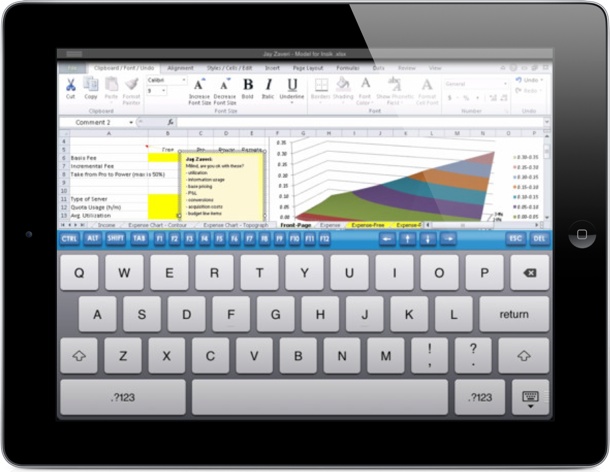Microsoft took its sweet time bringing Microsoft Office to mobile devices (it just announced Office for the iPhone last month), which left the door wide open for other solutions.
That’s where CloudOn and its cloud-powered mobile productivity software come in. CloudOn’s apps let you stream full versions of Microsoft Word, PowerPoint, and Excel on most mobile devices. It first launched on the iPad last year and has since brought its apps to the iPhone as well as to Android tablets and smartphones.
Plenty of other apps let you edit Office documents, but CloudOn is notable for building a virtualization platform that can scale to just about any device as well as handle many different types of software. The company also connects to cloud storage services like Google Drive, DropBox, Box, and Microsoft SkyDrive. As of February, the company claims its apps have been downloaded more than 3.5 million times.
We asked Jay Zaveri, CloudOn’s vice president of product, to explain how the company approached bringing one of the most popular productivity apps to a completely new platform. Zaveri and CloudOn’s CEO, Milind Gadekar, will also be diving deep into their approach to building an ideal mobile experience at our MobileBeat 2013 conference on Tuesday and Wednesday.
VentureBeat: How does CloudOn deal with the problem of building the ideal mobile experience — especially since you’re bringing over desktop apps to mobile?
Jay Zaveri: At CloudOn, we care deeply about user experience. CloudOn follows a device-specific design philosophy. For instance, given that the tablet is the key device for CloudOn users, we study the workflow of people on tablets and determine how we can make it easy for our users to access, create, review, and edit content. We have also focused a lot of our energy on making the Office suite usable – this includes improved tapability, a patent-pending gesture to mouse engine and modifications to the toolbar to offer the functionality that users want on tablets.
We follow a similar philosophy for every device we introduce CloudOn to. While we still have a long way to go before we’re fully satisfied, the results so far speak for themselves: a top 10 productivity app in 145 countries around the world, a 4-star rating on the Apple app store and 40 million documents edited by users with six million productivity hours spent with CloudOn.
VB: How is CloudOn approaching mobile monetization?
JZ: We believe in and 100 percent support a freemium model. While a majority of our users will use our service for free, those that want to push the envelope of productivity beyond what regular mobile devices allow will have the option to upgrade and pay for a pro version of our app. Our monetization model will likely cater to individuals initially, followed by teams and finally the enterprise. We plan to roll out our pro version fairly soon.
VB: What are the biggest challenges CloudOn is facing on mobile?
JZ: Developing rich applications for mobile is always a challenge. We believe our users should be able to use CloudOn on every device, but the fragmentation of operating systems makes it very hard to achieve ubiquity. The constantly shifting landscape of resolutions, sizes, and interaction paradigms compound the problem further.
VB: Since you’re relying so heavily on cloud services (it’s in your name!), how do you approach scaling?
JZ: We have built a platform that dynamically scales to serve tens of thousands of concurrent users through data centers in the US, Western Europe, Japan, Southeast Asia, Latin America, and Australia. This cloud-based platform runs a pool of “virtual application blocks” that users connect to when they need to create, review, or edit documents. We work hard at reducing latency by connecting users to the data center closest to them. We also focus on reliability, stability, redundancy and quality — our infrastructure is extremely complex, and without the power of the cloud none of this would have been possible.
VB: How is CloudOn attracting enterprises?
JZ: By delighting the users in the enterprise first! We provide a simple and easy-to-use app that gives our enterprise users the assurance that they can create, edit, or review documents, spreadsheets and presentations with full fidelity on their phones and tablets.


